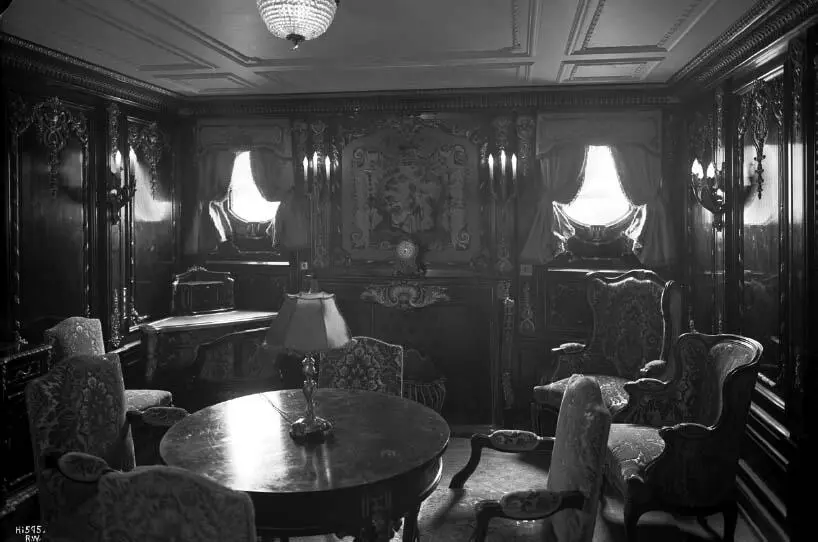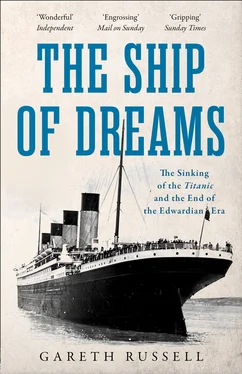They were escorted past the staircase, the Purser’s Office and its Enquiry Desk, which functioned much like the reception of a modern hotel, and into long white-panelled corridors leading to stateroom C-77. It was a particularly convenient relocation for Cissy, since her employer’s new room was opposite the small but comfortable special dining room set aside for maids, valets and other servants travelling with their employers.[37] Lady Rothes was, by European standards, the highest-ranking person on the ship, a silken-voiced embodiment of the empire of manners which the British aristocracy still commanded. With her caste’s social influence still tangible, Noëlle was not an anachronism on the Titanic , but she was an anomaly in being the only member of the nobility on board.[38] An old world silently passed a new one as the Countess’s party walked among the self-made millionaires and plutocrats who occupied most of the other C-Deck staterooms.

The parlour in the Strauses’ suite was identical on the Titanic and the Olympic . The desk where Ida wrote her letter to Lilian Burbidge can be seen on the far left.
Sitting room of first-class parlour suite on the Olympic , by Robert John Welch ( © National Museums NI)
Ten doors up from the Countess’s new stateroom, sixty-three-year-old Ida Straus, travelling with her husband Isidor, a former Democratic congressman for New York and co-owner of Macy’s department store, was thrilled with her quarters. The Strauses had taken a parlour suite, which gave them a bedroom, a drawing room, a bathroom and ample wardrobe space. The layout of their rooms, C-55 and C-57, was almost identical to the same suite on the Olympic , from which several photographs fortunately survive showing in detail the parlour and bedroom occupied by Ida Straus and her husband.[fn1][39] The drawing room was decorated in an Edwardian take on the Regency era, with three-armed candelabra mounted throughout on the room’s mahogany walls, flecked with interweaving gold leaf. A tapestry of a pastoral scene, vaguely in the style of Fragonard, was displayed between two curtain-draped portholes and above the fireplace with its electric heater. On a table in the centre of the room, a large bouquet of flowers had been waiting for Ida when she arrived, a gift from Lilian Burbidge, wife of Richard Burbidge, Managing Director of Harrods. The two couples had spent some time together during the Strauses’ recent stay in London, during which the Burbidges had taken them to theatre and supper, favours which Ida planned to repay when the British couple visited New York the following summer.
The Atlantic Ocean had framed Ida and Isidor Straus’s life together. Both were first-generation Americans, emigrating to the United States as children – in Isidor’s case from the kingdom of Bavaria and in Ida’s from the grand duchy of Hesse-Darmstadt, two decades before both territories were incorporated with varying degrees of unwillingness into a unified Imperial Germany. Transatlantic travel then had been fraught with possible dangers and certain discomfort, but it had already begun its meteoric sequences of improvement when the couple first met in New York in the 1860s, at a time when their families were on opposite sides of the American Civil War and Isidor, who had then lived in Georgia, was preparing to sail back to Europe to work as a blockade runner for the Confederacy. He had called on old friends of his family in New York, including the young Ida Blun’s parents, before booking passage to England, while maintaining the pretence of being a Northerner under which he had arrived. By the time they met again and fell in love, the Confederacy as a political actuality had been wiped from the face of the earth and the Strauses had emigrated once more, this time trading Georgia for New York. Since then, there had been numerous trips across the Atlantic for the couple, initially because of Isidor’s desire to remain in touch with his German relatives and to visit London, a city he had fallen in love with during his time there in the 1860s.[40] Ida preferred Paris, partly thanks to her love of shopping; her husband tolerated rather than enjoyed their stays there.[41]
Isidor remained fascinated by liners and their technology, so the couple made their way on deck for the send-off, stopping at the end of their corridor to chat with a stewardess, who had once attended to them on the Olympic and thought them ‘a delightful old couple – old in years and young in character – whom we were always happy to see join us’.[42] When they reached the deck, they fell into conversation with their friend Colonel Archibald Gracie IV, who like Isidor came from Confederate stock – his father, General Archibald Gracie III, had been killed by a Union shell at the Siege of Petersburg in 1864.[43] Knowing that mail would be taken off the ship at Cherbourg in a few hours’ time, Ida wanted to make sure she sent a prompt thank-you note to Lilian Burbidge for the flowers and, since the Strauses had been spending the winters in Europe away from their New York home every year since 1899, the anchors-away moment no longer held much of a thrill for Ida.[44] While Isidor stayed up top with Gracie, Ida, by 1912 plump and elegant with a cloud of dark hair beginning to show streaks of grey, with a prominent flesh-coloured mole on the lower left-hand side of her face and a warm smile which many people considered her best feature, made her way back to their suite, sitting at its little escritoire beneath one of the portholes, while her new maid, Ellen Bird, and Isidor’s English valet, John Farthing, began the long process of unpacking.[45] Ida was a particularly hands-on housewife, who was almost alone among the wealthy women of Manhattan in never having hired a housekeeper; Isidor was constantly urging her to take on fewer responsibilities.[46] It had been a series of nervous complaints and then problems with Ida’s heart, flaring up with regularity over the previous three years, that had turned their annual migration to the French Riviera into something approaching a necessity. When they could not spend too much time away from America, Ida had gone to relax at their beach house in New Jersey and once to California.[47] That year, they had left New York in January aboard the Cunard Line’s Caronia , which plied the route from Manhattan to the Mediterranean, and spent most of their holiday at a quiet hotel in Cannes, which Ida in a letter home to her married daughter, Minnie, had described as ‘a lovely spot for old people’.[48] But Ida had made something of a poor swap, since New York had one of the mildest winters that anyone could remember, while the Riviera was pelted by rain for most of February and March.[fn2]
From five decks beneath her, the Titanic ’s engines roared to life, producing a quiet hum beneath Ida’s feet and in the walls around her. Many of the passengers would remark later that the ship was so well designed that they were barely aware of the vibrations, although they certainly noticed them when they stopped, since the engines muffled much of the noise flowing between the relatively thin walls of the cabins.[49] The Strauses’ rooms, like the Countess’s, were on the Titanic ’s starboard side, facing away from the pier, but the noise would have given Ida a general idea of what was going on. Far above her, the scream of the ship’s whistles and the cheers of the crowd announced that it was time for the Titanic to make her midday departure, only a few minutes late.[50] Then, a silence fell as the engines cut out and the Titanic floated adrift in the River Test, until the reassuring growls of the machinery eventually returned and the journey continued.
Читать дальше













